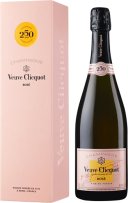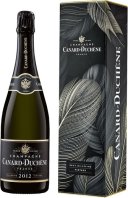Veuve Clicquot Non-Vintage Rose
Elegant and fruity, this wine frees the senses, charms the eye and ravishes the palate. Proudly bearing the imperial red signature of Madame Clicquot. It is a delicious rosé Champagne with plenty of character. 'THIS is one of the go-to French brands for a Valentine's moment. It's all about the name, the sunset brushstroke of this rose´ and its abundant presence in the glass. There is a cherry to redcurrant-fruit focus and even a background note of sarsaparilla.' - Herald Sun, Melbourne, 12 Feb 2013
Piper Heidsieck Rose Sauvage Non-Vintage
The deep, blushed rouge of this firm, well-structured, mouth-filling vinous Rose is underpinned by a powerful bouquet of plums and blackberries, and the rich flavours of forest fruits, pomegranate and raspberries. Regis Camus, International Wine Challenge Sparkling Winemaker of the Year 2004, 2007, 2008, 2009, 2010, 2011, 2012.
Veuve Clicquot Ponsardin Vintage
Veuve Clicquot has been producing fine quality Champagne since it was founded in 1772. In 1810, Madame Clicquot broke new ground by creating the first vintage Champagne, made of grapes from one single harvest. Veuve's non vintage is consistently rated in the top handful of NV Champagnes and delivers a powerful bubbly with a rich mouthfeel. The Ponsardin vintage is elegant with generous freshness and the Pinot Noir lends body to a very lively wine. On the palate there's layers of floral and fruity complexity that flows into a remarkably long and powerful finish.
Piper-Heidsieck Brut Non-Vintage Champagne
A fresh citrus driven Champagne with layers of summer fruits. A popular choice when you want the real deal to celebrate weddings, parties, anything. Excellent value for a fine bottle of bubbles. Regis Camus, International Wine Challenge Sparkling Winemaker of the Year 2004, 2007, 2008, 2009, 2010, 2011, 2012, 2013.
Louis Roederer Brut Premier Non-Vintage Champagne
Louis Roederer Champagne embodies style and class. Delve into the toasty aromatics, apple and nougat flavours and tingling freshness. There's generous structure, length and complexity not always found in NV Champagne.
Castelnau Champagne Brut Vintage
Located in the heart of Reims, Champagne, Castelnau represents the very essence of the region, with access to 900 hectares of vineyards across 155 crus, creating a unique grape growers collective that guarantees exceptional supply possibilities for the production of outstanding Champagne. Known for its extensive lees ageing, Champagne Castelnau has a long established reputation for its top quality range. Exceptionally, this Champagne has had more than 10 years of ageing on its lees, giving it remarkable complexity and depth. This vintage offers an aromatic harmony of grilled, toasty notes and the well-rounded body is thanks to the Chardonnay in the blend that has been grown in the Grande Montagne de Reims. Citrus fruit, such as grapefruit, caress the taste buds and impart a distinguished freshness. The spicy notes on the finish are a signature style of Champagne Castelnau.
Champagne Deutz Brut Classic Non-Vintage
Canard Duchene Brut Vintage Champagne
Canard Duchene Brut Vintage Champagne Gift Box is a top pick for celebrating life's special moments. This vintage champagne, with its toasty notes and hints of white flowers and citrus, comes from the Montagne de Reims vineyards and is sure to please. Full-bodied and refreshing, Canard Duchene Brut Vintage Champagne makes a great gift. The champagne house is located in Ludes, in the Montagne de Reims National Park since 1868. These authentic, original Champagnes combine fruit, intensity and complexity. While the majority of leading Champagne houses are located in the urban setting of Reims or Epernay, Canard-Duchêne is unusually situated in Ludes, on a hillside, at the very heart of the Montagne de Reims vineyards. Located within the limits of the most prestigious terroirs, Ludes epitomises the magnificence of Pinot noir cultivated in Champagne. Toasted notes, revealing hints of white and citrus flowers upon aeration. Full-textured on the palate with a long finish.
Penfolds x Thienot Champagne Rose Brut Non-Vintage GB
Well-balanced with subtle mandarin and raspberry fruits over a flavour base of strawberry, Turkish Delight and pistachio. Penfolds partnered with Thiénot, a respected player in the world of Champagne, to create this non-vintage champagne brut rosé. Colour: Youthful, bright/vivid pale-salmon Aromas: An ascent of (textbook) grenadine fruits – Avec raspberry, redcurrant, blackcurrant and strawberry. Sans pomegranate. And the citrus - pink grapefruit / mandarin marmalade. And the florals/confiserie – scents of Anis de Flavigny Violet Pastiles or Violets of Toulouse; lily. Upon sitting – wafts of cherry jam, sorry confiture. Palate: Inviting, exotic. Balanced, with an overt freshness - crispness up-front, and a delicate dosage imprint on finish. Relaxed acidity, friendly effervescence. Subtle mandarin and raspberry fruits impact immediately – over a flavour base of strawberry with pepper / Turkish Delight with pistachio. Stylistically light on its feet and sprightly … its ‘Champagne character’ teasingly revealed upon sitting. Impatience? A second glass immediately beckons. Peak Drinking: Now onwards, yet recommend to ideally drink in youth - perfect at the moment!
Pol Roger Reserve Brut Non-Vintage ( )
Now this half bottle is handy if you wish to toast yourself. Pol Roger is one of the world's power house champagne houses. Famously quoted by the likes of Winston Churchill and the champagne of choice for Her Majesty the Queen. An equal blend of chardonnay, pinot noir and pinot meunier, with addition of 20% reserve wines. It is impressively fresh and vivacious with more depth than most aperitif styles.














